LMU Munich
University of Oxford
Gothic, intro, unit 1
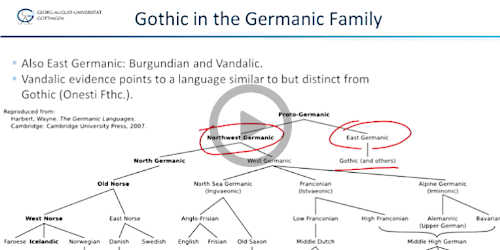
DOI: https://doi.org/10.5446/49502
linguistic affiliations and external history: history and relationships of the Goths
slidesGothic, sounds, unit 1
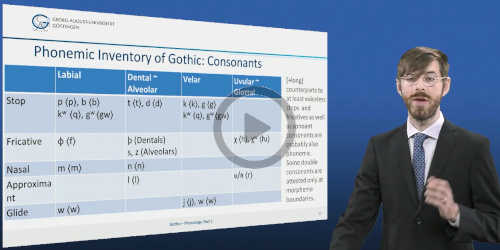
DOI: https://doi.org/10.5446/49511
orthographic interpretation and phonemic system: spelling-sound correspondences, segmental inventory, phonemic analysis
slidesGothic, words, unit 1
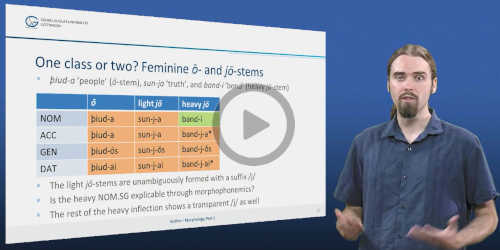
DOI: https://doi.org/10.5446/49509
noun stem formation and composition: nominal system, stem formation, major noun classes, nominal composition
slidesGothic, words, unit 2
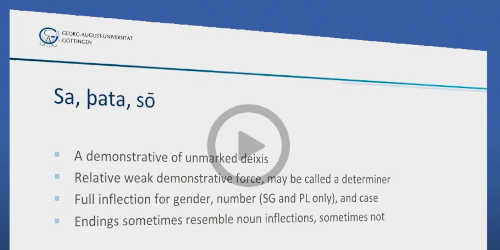
DOI: https://doi.org/10.5446/49508
adjectives, demonstratives and pronouns: inflection, gradation of adjectives, classes of pronouns, participles
slidesGothic, structures, unit 1
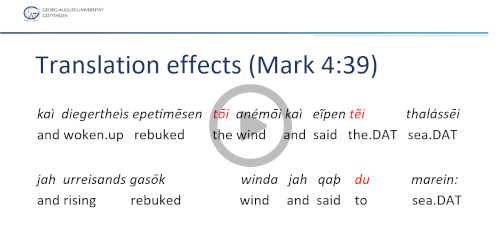
DOI: https://doi.org/10.5446/49505
overview: translation effects, linearization, gender and agreement, number, case, possession, definiteness
slidesGothic, structures, unit 2
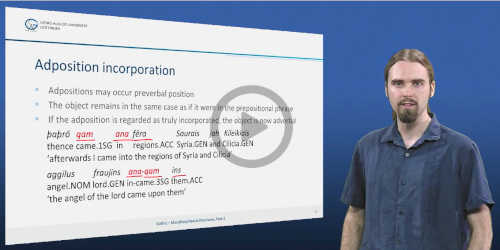
DOI: https://doi.org/10.5446/49500
arguments and valency: alignment and subjects, causatives and transitivity, voice, adposition incorporation
slidesselection out of the lecturers’ references, enriched by Lars Ahrens and project members:
general introductions, encyclopedias, literature, writing, history, miscellaneous
Falluomini, Carla. 2015. The Gothic Version of the Gospels and Pauline Epistles: Cultural Background, Transmission and Character. Berlin: de Gruyter.
Harbert, Wayne. 2007. The Germanic Languages. Cambridge: Cambridge University Press.
Lambdin, Thomas O. 2006. An Introduction to the Gothic Language. Eugene: Wipf & Stock.
Snædal, Magnús H. 2013. A Concordance to Biblical Gothic, Vol. 1: Introductions, Texts; Vol. 2 Concordance. 3rd edn. 2 Vols. Reykjavík: University of Iceland.
Lexicity. 2016. Gothic. (Accessed 2021-06-24.)
Nègre, Xavier. 2002-2021. Lexilogos (Accessed 2021-07-05.)
grammars, treatments of major grammatical domains
Miller, D. Gary. 2019. The Oxford Gothic Grammar. Oxford: Oxford University Press.
Ferraresi, Gisella. 2005. Word order and phrase structure in Gothic. Leuven: Peeters.
Streitberg, Wilhelm. 1920. Gotisches Elementarbuch. 5th edn. Heidelberg: Winter. (digitized version at the Internet Archive.) (Accessed 2021-07-05.)
See also a list of grammars on Lexicity 2016 and Lexilogos.
dictionaries, headword search tools, further sources of information about the lexicon
Lehmann, Winfred P. 1986. A Gothic Etymological Dictionary: Based on the Third Edition of Vergleichendes Wörterbuch der gotischen Sprache by Sigmund Feist. Leiden: Brill.
Streitberg, Wilhelm. 1910. Die Gotische Bibel. Zweiter Teil: Gotisch-griechisch-deutsches Wörterbuch. Heidelberg: Carl Winter’s Universitätsbuchhandlung. (digitized version at the Wulfila Project) (Accessed 2021-05-07.)
Project Wulfila. 2004. Dictionary. (Accessed 2021-07-05.)
See also a list of dictionaries on Lexicity 2016 and Lexilogon.
text collections, corpora, treebanks
Balg, Gerhard H. 1891. The First Germanic Bible. Milwaukee: self-published. (digitized version at the Internet Archive) (Accessed 2021-07-05.)
Gippert, Jost & Martinez, Javier & Korn, Agnes & Mittmann, Roland. 2016. TITUS TEXTUS: Thesaurus Indogermanischer Text- und Sprachmaterialien. Frankfurt: University of Frankfurt. (Accessed 2021-06-25.)
Uppsala University Library. No date. Codex Argenteus. (Accessed 2021-07-05.)
See also a digitized version of the Gothic Bible at the Wulfila Project, see also a selection of available texts on Lexicity 2016.
coursebooks, exercises, materials or introductions supporting teaching
Krause, Todd B. & Slocum, Jonathan. 2004. Early Indo-European Online: Gothic Online. University of Texas: Linguistics Research Centre. (Accessed 2021-06-24.)